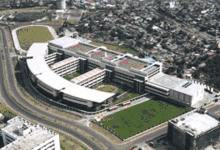International School Manila
| International School Manila | |
|---|---|
 | |
| Location | |
|
University Parkway, Bonifacio Global City, Taguig City, Metro Manila Philippines | |
| Information | |
| Type | Private International School |
| Motto |
Veritas et Democratia Truth and Democracy |
| Established | 1920 |
| Superintendent | David Toze |
| CEEB code | 705720 |
| Faculty | 226 |
| Grades | Preschool to Grade 12 |
| Enrollment | 2,266 |
| Campus | University Parkway |
| Campus size | 17 acres (0.069 km2) |
| Color(s) |
Green (Primary) Gold (Secondary) |
| Athletics conference | Interscholastic Association of Southeast Asian Schools (IASAS) |
| Mascot | Bearcat |
| Nickname | International School Manila Bearcats |
| Website |
www |
Coordinates: 14°33′17″N 121°03′29″E / 14.5546°N 121.058°EInternational School Manila (abbreviation: ISM) is a private, non-profit, non-sectarian day school for boys and girls from Preschool to Grade 12, located in Bonifacio Global City, Taguig, Metro Manila, Philippines. It is governed by a ten-member Board of Trustees elected from and by the parents of enrolled students and by Sustaining Members of the Corporation.
Founded in 1920 by a group of American and British parents living in Manila, The American School changed its name to International School Manila in 1970 at the recommendation of the US Embassy to reflect the growing student diversity on campus.
International School Manila is one of six members of the Interscholastic Association of Southeast Asian Schools (IASAS)
History
In 1920, a group of American and British expatriates established the American School, Inc., which opened its doors on June 21, 1920 located at 606 Taft Avenue, a loaned church building, with eight teachers and fifty students from Grades 1 to 12. The American School (AS) moved locations twice in this decade: in 1922 to Padre Faura Street and in 1920 to MH Del Pilar St. Both were Spanish-style colonial homes.
In 1930, the American Indian became the AS symbol. Just after the Christmas holidays of 1936, the school moved again; this time to a campus on Donada Street.
On January 2, 1942, Japanese troops arrived in Manila. All citizens of the Allied countries were interned at the University of Sto. Tomas. Heads of various schools organized classes within the internment camp and these ran until 1945. A total of thirty-four students completed their High School requirements and graduated during WWII. In September 1946, exactly one year after the Japanese surrendered in Manila, the American School re-opened at Donada Street.
In 1970, the American School changed its name to International School Manila at the recommendation of the US Embassy to reflect the growing student diversity on campus. In the same year, IS Manila also became the first international school to receive Accreditation by Western Association of Schools and Colleges (WASC). In 1976, the International Baccalaureate Program was introduced to the High School curriculum.
In 1982, ISM joined the Interscholastic Association of Southeast Asia Schools (IASAS).
1994 marked the last year of the Indian symbol. The Bearcat was announced as the official mascot beginning SY 1995-1996. In 1999, the current globe logo was introduced as the official emblem, replacing the Indian insignia.
After forty years at the Bel-Air campus, in 2002, International School Manila moved to a purpose-built campus on a 7-hectare site in Bonifacio Global City.
Campus and facilities

The ISM campus sits on 7 hectares located at the new Global City development at Fort Bonifacio, Metro Manila.
Facilities include:
- 400m all-weather track and 3 playing fields
- 3 Libraries with over 80,000 books
- 920-seat Fine & Performing Arts Theater
- 350-seat Little Theater for multi-purpose activities
- Amelita M. Ramos Hall: performance space with retractable seating and modular stage
- Design Technology and Robotics Suite
Organization and leadership
ISM is organized into three divisions:
The Elementary School comprises seven year levels: Preschool (covering two years), Kindergarten, and Grades 1 to 4. The age range of our students is from three to ten years.
The Middle School comprises four grade levels, Grade 5 through Grade 8. The age range is from ten to fourteen.
The High School comprises Grades 9, 10, 11 and 12.
The Leadership Team consists of:
- Superintendent
- Assistant Superintendent
- High School Principal
- High School Assistant Principal
- Middle School Principal
- Middle School Assistant Principal
- Elementary School Principal
- Elementary School Assistant Principal
- Student and Faculty Learning Coordinator
The school is governed by a ten-member Board of Trustees elected from and by the parents of enrolled students and by Sustaining Members of the Corporation. The Superintendent serves as the head of the school.
Student body
There are a total of 2,266 enrolled students at ISM with over 80 countries represented.
Elementary School = 759
Middle School = 691
High School = 816
The Elementary School, Middle School and High School have their own Administration and Faculty.
Faculty
The 226 faculty members working at ISM come from over twenty different countries:
- USA - 41.59% (94 members)
- UK - 22.12% (50 members)
- Canada - 11.50% (31 members)
- Philippines - 5.75% (13 members)
- Australia - 3.98% (9 members)
- New Zealand - 2.21% (5 members)
- France - 1.77% (4 members)
- South Africa - 1.77% (4 members)
- Italy - 1.33% (3 members)
- China - 0.88% (2 members)
- Ireland - 0.88% (2 members)
- Japan - 0.88% (2 members)
- Spain - 0.88% (2 members)
- Austria - 0.44% (1 member)
- Germany - 0.44% (1 member)
- Hungary - 0.44% (1 member)
- India - 0.44% (1 member)
- Korea - 0.44% (1 member)
- Malaysia - 0.44% (1 member)
- Netherlands - 0.44% (1 member)
- Singapore - 0.44% (1 member)
Extracurricular activities
Athletics and activities
ISM competes both locally and internationally in Soccer, Volleyball, Cross-Country, Tennis, Basketball, Swimming, Rugby, Touch, Track and Field, Softball, Badminton, Table Tennis, Gymnastics, Golf, Wall Climbing, Judo and Tae Kwon Do.
Students from ISM also have the opportunity to travel and compete with other premier international schools in academic and artistic competitions through the Interscholastic Association of Southeast Asian Schools (IASAS) organization.
There are over 30 clubs, councils, societies and media publications at ISM.
Fine and performing arts
ISM offers opportunities for performers to share their work with both local and international audiences. Every year an array of drama performances, music concerts, dance recitals, art exhibitions and public speaking events in varied forms are showcased for the ISM community to enjoy.
After-school activities
ISM provides opportunities for students to engage in safe and fun recreational activities that extend their educational experience at ISM. This program is offered to students who want to keep active, develop skills and take part in a rotating selection of sports and activities.
Bamboo Telegraph
Bamboo Telegraph (BT) is ISM's official high school student publication which was launched in 1936. Since its beginnings eighty years back, BT has undergone numerous changes, yet has still maintained the high caliber of student journalism in ISM.
SY 2017-2018 Features Editors Joaquin Mayo Woosuk Kim
Sailfish Swimming
The Sailfish Swim Club is made up of ISM students from Grades 1 to Grade 12, with a current roster of 155 members. The Club trains throughout the whole school year in ISM's 25-meter 8-lane pool. Sailfish Swim Club hosts and attends swim meets in Manila, as well as international schools within Southeast Asia.